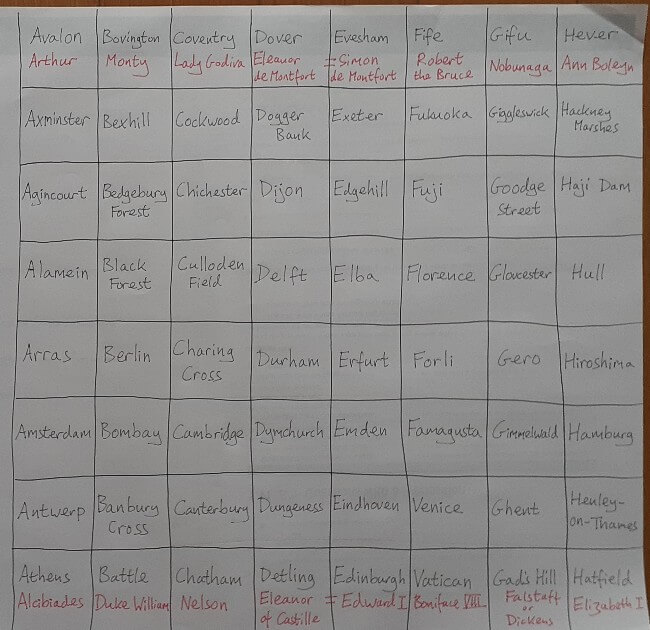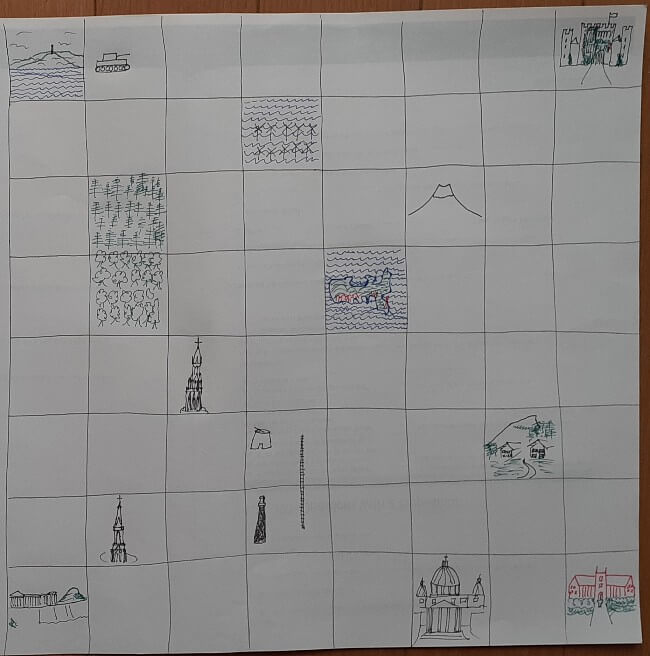Over the past year or so I have been developing a memory system for my chess opening repertoires for both White and Black using a version of the Major System. I have blogged about the system here on Hive and also on my personal blog:
This month I decided to spice things up by creating a chess board memory palace in which each square is given a placename.
In addition, the pieces would be given names are related to the places they occupy at the beginning of the game.
The idea is that I will be able to add a lot of vivid imagery and storytelling to my opening repertoire memory system as extra stimuli to help with recall.
Choosing Placenames for the Squares
I decided to convert the rank number into a consonant using the Major System as a guide:
1 = "t" or "d" (or "th")
2 = "n"
3 = "m"
4 = "r"
5 = "l"
6 = "j" or soft "g" or "dge" or "ch"
7 = "k" or "x" or " hard "g"
8 = "f" or "v"
I decided that locations should begin with the file letter of the square they are naming. So all the "a" file squares would be given placenames beginning with the letter "A," all the "b" file squares would be given placenames beginning with "B" and so on.
In the case of places beginning with "C," I avoided soft cs (such as Cirencester for c4) and chose placenames beginning either with a hard "c" (Coventry for c8) or with a "Ch" (Chichester for c6).
For the "f" file I chose placenames beginning with "F" or "V" (Vatican for f1, Florence for f4).
Some combinations were much easier to find names for than others. For some squares there was a range of good choices, less so for others. Finding placenames for squares on the "a" rank was easy enough:
a1 = A + t = Athens
a2 = A + n = Antwerp
a3 = A + m = Amsterdam
a4 = A + r = Arras
a5 = A + l = Alamein
a6 = A + soft g = Agincourt
a7 = A + x = Axminster
a8 = A + v = Avalon
Finding names for the "g" file was more of a challenge, however.
Whenever there was a choice, I chose names that meant more to me based on my own history or my own sense of history. So there are quite a few references to English places, European places and Japanese places, or to historical (or in one case mythical) places that mean something to me.
One example is my choice of "Alamein" over "Alamo" for a5. Another preference was for the little village of Gimmelwald in Switzerland over the island of "Guam" for g3.
I also have to apologize to any French readers for favouring the mythical "Avalon" for the fine French city of "Avignon" for a8!
Each to his own.
Here is the completed version of the chessboard placename memory palace:

Naming the Back Rank Pieces
I have named all the backrank pieces after people associated with the places they occupy. I was especially pleased with how coincidentally things worked out for naming the Kings and Queens.
e1 = Edinburgh = Edward 1st who conquered Edinburgh
d1 = Detling = Eleanor of Castille, wife of Edward 1st. She lived in Leeds Castle, near Detling, in Kent.
e8 = Evesham = Simon de Montfort, de facto ruler of England until his defeat by Prince Edward (later Edward 1st) at the Battle of Evesham, 1265.
d8 = Dover = Eleanor de Montfort, wife of Simon de Montfort, who lived in Dover Castle.
Here is the beginnings of a pictorial version to help impress the placenames on my memory:

That's enough for one post. I'll give some examples of how it all works to remember move sequences in a future post!
To conclude, here is a link to a report about how Timur Gareyev broke the world record for a blindfold simul chess challenge against 48 opponents by turning memory techniques such as these into mental superpowers!
https://en.chessbase.com/post/memory-techniques-the-chess-equation
David Hurley
#InspiredFocus
Check out my chess blog @ https://easychesstips.com
hi @hirohurl, thanks for sharing your research on "Chess Memory Techniques". I have a way to go before understanding but I will continue to review it.
Thanks for popping by, @rodrook! If anything needs clarifying, just ask away!
Haha, so confusing at a first glance, but most important is that it helps you! :)
Thanks, @jaki01! I think the jury is still out on whether it really helps or not! It's been a lot of fun to create though...